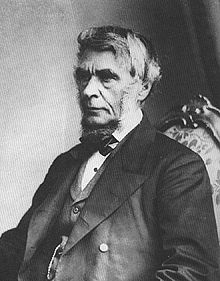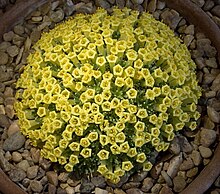George Bentham
George Bentham | |
|---|---|
 | |
| Born | 22 September 1800 Stoke Damerel, Plymouth,England |
| Died | 10 September 1884(aged 83) London,England |
| Spouse | Sarah Jones |
| Awards | Royal Medalof theRoyal Societyin 1859 Clarke Medalof theRoyal Society of New South Walesin 1879 |
| Scientific career | |
| Fields | Botany |
| Institutions | Royal Botanic Gardens, Kew |
| Author abbrev. (botany) | Benth. |
George BenthamCMGFRSFLS(22 September 1800 – 10 September 1884) was an Englishbotanist,described by the weed botanistDuane Iselyas "the premier systematic botanist of the nineteenth century".[1]Born into a distinguished family, he initially studied law, but had a fascination with botany from an early age, which he soon pursued, becoming president of theLinnaean Societyin 1861, and a fellow of theRoyal Societyin 1862. He was the author of a number of important botanical works, particularly flora. He is best known for his taxonomicclassification of plantsin collaboration withJoseph Dalton Hooker,hisGenera Plantarum(1862–1883). He died in London in 1884.
Life
[edit]Bentham was born inStoke, Plymouth,on 22 September 1800.[2][3]His father, SirSamuel Bentham,anaval architect,was the only brother ofJeremy Benthamto survive into adulthood. His mother,Mary Sophia Bentham,was abotanistand author.[a]Bentham had no formal education but had a remarkable linguistic aptitude. By the age of seven, he could speak French, German and Russian, and he learnedSwedishduring a short residence in Sweden while still a child. The family made a long tour through France, staying two years atMontauban,where Bentham studiedHebrewand mathematics in the Protestant Theological School. They eventually settled nearMontpellierwhere Sir Samuel bought a large estate.[5]
While studying atAngoulême,Bentham came across a copy ofA. P. de Candolle'sFlore française,and became interested in the analytical tables for identifying plants. He immediately tested them on the first plant he saw. The result was successful and he applied it to every plant he came across. In London in 1823, he met English botanists. His uncle pushed him to study law atLincoln's Inn.He wascalled to the barand in 1832 held his first and onlylegal brief.[5] However, his interest in botany never flagged and he became secretary of theHorticultural Society of Londonfrom 1829 to 1840.[6]
In 1832, he inherited the property of his uncle,Jeremy Bentham.Having inherited his father's estate the previous year, he was now sufficiently well off to do whatever he wanted, which wasbotany,jurisprudenceandlogic.[7]
Bentham married Sarah Jones (1798–1881), daughter ofSir Harford Jones Brydges,on 11 April 1833; they did not have children.[8]
Bentham died at his London home on 10 September 1884, aged 83.[3]He was interred inBrompton Cemetery.
Career
[edit]Views on evolution
[edit]Bentham's life spanned the Darwinian revolution, and his young colleagueJoseph Dalton HookerwasDarwin's closest friend and one of the first to accept Darwin's ideas. Until then, Bentham unquestioningly believed that species were fixed. In 1874 he wrote that "Fifteen years have sufficed to establish atheory of evolution by natural selection".[9]Bentham's conversion to the new line of thought was complete, and included a change fromtypology in taxonomyto an appreciation that "We cannot form an idea of a species from a single individual, nor of a genus from a single one of its species. We can no more set up a typical species than a typical individual."[10]
Honours and awards
[edit]Bentham was awarded theRoyal Medalof theRoyal Societyin 1859 and elected aFellowin 1862.[11]He served as president of theLinnean Society of Londonfrom 1861 to 1874.[12]He was elected a Foreign Honorary Member of theAmerican Academy of Arts and Sciencesin 1866.[13]He was appointedCMG(Companion of St Michael & St George) in 1878. His foreign awards included theClarke Medalof theRoyal Society of New South Walesin 1879.
Works
[edit]Bentham's first publication was hisCatalogue des plantes indigènes des Pyrénées et du Bas Languedoc(Paris 1826), the result of a careful exploration of thePyreneesin company withG. A. Walker Arnott(1799–1868), afterwards professor of botany in theUniversity of Glasgow.In the catalogue Bentham adopted the principle from which he never deviated, of citing nothing at second-hand. This was followed by articles on various legal subjects: oncodification,in which he disagreed with his uncle, on the laws affecting larceny and on thelaw of real property.But the most remarkable production of this period was theOutline of a New System of Logic: With a Critical Examination of Dr. Whately's Elements of Logic(1827).[14]In this the principle of thequantification of the predicatewas first explicitly stated. ThisStanley Jevonsdeclared to be undoubtedly the most fruitful discovery made in abstract logical science since the time ofAristotle.Before sixty copies had been sold the publisher became bankrupt and the stock went for wastepaper. The book passed into oblivion, and it was not until 1873 that Bentham's claims to priority were finally vindicated against those of SirWilliam HamiltonbyHerbert Spencer.[15]
In 1836 he published hisLabiatarum genera et species.In preparing this work he visited, between 1830 and 1834, every European herbarium, several more than once. The following winter was passed inVienna,where he produced hisCommentationes de Leguminosarum generibus,published in the annals of the Vienna Museum. In 1842 he moved toPontrilasin Herefordshire. His chief occupation for the next few years was his contributions to theProdromus Systematis Naturalis Regni Vegetabilis,which was being carried on by his friend,A. P. de Candolle.In all these dealt with some 4,730 species.[15]
In 1844, he provided the botanical descriptions forThe Botany of the Voyage of H.M.S. Sulphur.[16]The editor,Richard Brinsley Hinds,had beensurgeononHMSSulphur1835-41 while she explored thePacificcoast of theAmericas.[17]
In 1854 he found the maintenance of a herbarium and library too expensive. He, therefore, offered them to the government on the understanding that they should form the foundation of such necessary aids to research in theRoyal Botanic Gardens, Kew.At the same time, he contemplated the abandonment of botanical work. However, he yielded to the persuasion of SirWilliam Jackson Hooker,John Lindleyand other scientific friends. In 1855 he took up his residence in London, and worked at Kew for five days a week, with a brief summer holiday, from this time onwards until the end of his life.[15]
In 1857, the government sanctioned a scheme for the preparation of a series of Floras or descriptions in the English language of the indigenous plants of British colonies and possessions. Bentham began with theFlora Hongkongensisin 1861, which was the first comprehensive work on any part of the little-known flora of China and Hong Kong, includingHong Kong croton.This was followed by theFlora Australiensis,in seven volumes (1863–1878), the first flora of any large continental area that had ever been finished. His greatest work was theGenera Plantarum,begun in 1862, and concluded in 1883 in collaboration withJoseph Dalton Hooker.[18][15]His most famous work, however, was theHandbook of the British flora,begun in 1853 and first published in 1858. This was used by students for over a century, running into many editions. After his death, it was edited by Hooker, and was known simply asBentham & Hooker.He is most famous for his extensive and excellent classification of plants, especially angiosperms, along with Hooker, forming the "Bentham & Hooker system",which was published in three volumes asGenera Plantarumbetween 1862 and 1883.
Selected publications
[edit]- "On the Distribution of the Monocotyledonous Orders into Primary Groups, more especially in reference to the Australian Flora, with notes on some points of Terminology".Journal of the Linnean Society of London, Botany.15(88): 490–520. February 1877.doi:10.1111/j.1095-8339.1877.tb00261.x.Zenodo:1432977.
- Genera plantarum ad exemplaria imprimis in herbariis kewensibus servata definita(3 vols.).London: L Reeve & Co. 1862–1883.
- Outline of a New System of Logic: With a Critical Examination of Dr. Whately's "Elements of Logic.London: Hunt and Clarke. 1827.ISBN9780598395641.
- The Botany of the Voyage of H.M.S. Sulphur. under Captain Ed. Belcher The Botanical descriptions by George Bentham: Text.Lords Commissioners of the Admiralty.1846 – via Smith Elder and Co.
Legacy
[edit]
The following plants have been named in his honour:
Genera
[edit]Species
[edit]- Acanthocephalus benthamianusRegel
- Andropogon benthamianusSteud.
- Gardenia benthamianusF.Muell.
- Croton benthamianusMüll.Arg.
- Distemonanthus benthamianusBaill.
- Garcinia benthamiana(Planch.&Triana)Pipoly
- Nicotiana benthamianaDomin
- Pinus ponderosa ssp. benthamianaHartw.
- Thelymitra benthamianaRchb.f.
- Verbascum sinaiticum
See also
[edit]- Bentham & Hooker system– System of plant classification
- Bentham's taxonomic arrangement of Adenanthos– Genus in plant family Proteaceae
- Bentham's taxonomic arrangement of Banksia– 1870 arrangement of the Australian endemic plant genus Banksia
- Category:Taxa named by George Bentham
Notes and references
[edit]Notes
[edit]Citations
[edit]- ^Isely 2002,pp. 163–166.
- ^Anon 1999,p. 43.
- ^abAmigo 2017,p.[page needed]
- ^Shteir 1984,p.71.
- ^abThiselton-Dyer 1911,p. 746.
- ^Cribb 2010,pp. 183–184.
- ^Thiselton-Dyer 1911,pp. 746–747.
- ^Burke 1906,p.[page needed].
- ^Green 1914,p. 498.
- ^Green 1914,p. 499.
- ^Proceedings of the Royal Society of London1885,p. i–v.
- ^Botanical Gazette1885,pp. 211–213.
- ^American Academy of Arts and Sciences 2006,p. 40.
- ^Bentham 1827.
- ^abcdThiselton-Dyer 1911,p. 747.
- ^Bentham 1846.
- ^Plarr & Royal College of Surgeons of England 2006,RCS: E002231.
- ^Bentham & Hooker 1862–1883.
- ^International Plant Names Index.Benth.
Sources
[edit]- American Academy of Arts and Sciences (2006). "B".Book of Members: 1780-2005(PDF).Cambridge, MA: American Academy of Arts and Sciences.OCLC70224250.Archived fromthe original(PDF)on 23 November 2018.
- Amigo, Jean-Jacques (2017). "Bentham (George)".Nouveau Dictionnaire de biographies roussillonnaises (1789-2017)[New Dictionary of Roussillon biographies (1789-2017)] (in French). Vol. 3, Sciences de la Vie et de la Terre. Perpignan: Publications de l'olivier.ISBN978-2-908866-50-6.OCLC1012939774.[page needed]
- Anon (1999).A Dictionary of Scientists.Oxford: University Press.ISBN978-0-19-280086-2.
- Bettany, George Thomas(1885)..InStephen, Leslie(ed.).Dictionary of National Biography.Vol. 4. London: Smith, Elder & Co.
- Burke, Bernard(1906). Burke, Ashworth Peter (ed.).A Genealogical and Heraldic History of The Landed Gentry of Great Britain.Vol.[,volume &, issue needed],(11th ed.). London: Harrison & sons.OCLC1336190250.
- Cribb, Phillip (12 December 2010)."The orchid collections and illustrations of Consul Friedrich C. Lehmann".Lankesteriana.10(2–3).Biographies.doi:10.15517/lank.v10i2-3.18317.ISSN2215-2067.
- "George Bentham".Botanical Gazette.10(1): 211–213. 1885.doi:10.1086/325816.ISSN0006-8071.JSTOR2994865.
- Green, Joseph Reynolds(1914).A History of Botany in the United Kingdom from the Earliest Times to the End of the 19th Century.London: J. M. Dent & sons.
- Isely, Duane (2002).One Hundred and One Botanists.Purdue University Press.ISBN978-1-55753-283-1.
- "Obituary notices of fellows deceased".Proceedings of the Royal Society of London.38(235–238). 1885.doi:10.1098/rspl.1884.0053.ISSN0370-1662.
- Plarr, Victor;Royal College of Surgeons of England(2006) [1930]."Hinds, Richard Brinsley (1812 - 1847)".Plarr's Lives of the Fellows Online.[London, England]: Royal College of Surgeons of England, Library & Information Services.OCLC646581474.
- Shteir, Ann B. (1984)."6. Linnaeus's Daughters: Women and British Botany".In Harris, Barbara J.; McNamara, Jo Ann (eds.).Women and the structure of society: selected research from the Fifth Berkshire Conference on the History of Women.Durham, N.C.: Duke University Press. pp. 66–73.ISBN978-0-8223-0603-0.OCLC988155630– via Internet Archive.
- Thiselton-Dyer, William Turner(1911)..InChisholm, Hugh(ed.).Encyclopædia Britannica.Vol. 3 (11th ed.). Cambridge University Press. pp. 746–747.
Further reading
[edit]- Jackson, Benjamin Daydon(1906).George Bentham.J.M. Dent. & Company.
- Bentham, George (1997). Filipuik, Marion (ed.).George Bentham: Autobiography, 1800-1834.University of Toronto Press.ISBN978-0-8020-0791-9.
- Bentham, George (1839–1857).Plantas Hartwegianas.
External links
[edit]- Works by or about George Benthamat theInternet Archive
- "Bentham, George"atBotanicusMissouri Botanical Garden Library
- George Bentham
- 1800 births
- 1884 deaths
- 19th-century British botanists
- 19th-century English people
- Botanists active in Kew Gardens
- Botany in Australia
- British pteridologists
- Burials at Brompton Cemetery
- Companions of the Order of St Michael and St George
- English botanists
- English taxonomists
- Environment of Hong Kong
- Fellows of the American Academy of Arts and Sciences
- Fellows of the Royal Society
- Fellows of the Zoological Society of London
- Presidents of the Linnean Society of London
- Royal Medal winners
- Scientists from Plymouth, Devon
